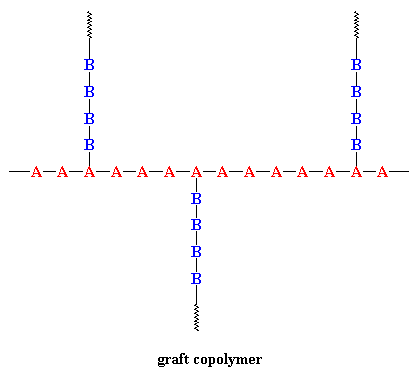
|
|
Most polymers are made by linking only one type of small molecule, or monomer, together. These are called homopolymers. When two different types of monomers are joined in the same polymer chain, the polymer is called a copolymer. This is another good way to make polymers that have the good qualities of two or more different polymers. This combining of parts to give something lots better is called "synergy."
Let's imagine now two monomers, which we'll call A and B. A and B can be made into a copolymer in many different ways.
When the two monomers are arranged in an alternating fashion, the polymer is called, of course, an alternating copolymer:

In a random copolymer, the two monomers may follow in any order:

In a block copolymer, all of one type of monomer are grouped together, and all of the other are grouped together. A block copolymer can be thought of as two homopolymers joined together at the ends:
A block copolymer that you know very well, if you wear shoes, is SBS rubber. It's used for the soles of shoes and for tire treads, too. SBS has some of the good qualities of each of its two parts - styrene plastic and butadiene rubber. This makes the copolymer harder and stiffer than regular rubber, plus makes it wear better and last longer- synergy again.
When chains of a polymer made of monomer B are grafted onto a polymer chain of monomer A, we have a graft copolymer:
One kind of graft copolymer is high-impact polystyrene, or HIPS for short. It is a polystyrene backbone with chains of polybutadiene grafted onto the backbone. The polystyrene gives the material strength, but the rubbery polybutadiene chains give it resilience to make it less brittle. The synergy here means the polystyrene cores makes it strong while the polybutadiene parts make it tough.



|
Return to Making Things Out of Polymers |

|
Return to Main Page |